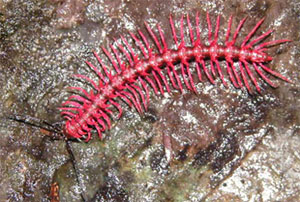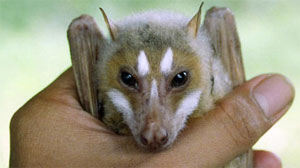16,969 species discovered in 2006
50 species per day discovered in 2006
mongabay.com
May 27, 2008
|
|
16,969 species were discovered in 2006 according to a report compiled by Arizona State University’s International Institute for Species Exploration, the International Commission on Zoological Nomenclature, the International Plant Names Index, and Thompson Scientific.
The authors say the report, titled State of Observed Species, is a “report card on human knowledge of Earth’s species.” It includes a list of the top 10 new species described in 2007.
“The international committee of taxon experts who made the selection of the top 10 from the thousands of species described in calendar year 2007 is helping draw attention to biodiversity, the field of taxonomy, and the importance of natural history museums and botanical gardens in a fun-filled way,” said Professor Quentin Wheeler, an entomologist and director of ASU’s International Institute for Species Exploration.
 Shocking pink dragon millipede (Desmoxytes purpurosea) from Thailand. According to its discoverers, this millipede’s gaudy coloration “probably indicates to would-be predators that it is not edible.” Courtesy of ASU’s International Institute for Species Exploration. |
“We live in an exciting time. A new generation of tools are coming online that will vastly accelerate the rate at which we are able to discover and describe species,” he continued. “Most people do not realize just how incomplete our knowledge of Earth’s species is or the steady rate at which taxonomists are exploring that diversity. In 2006, for example, an average of nearly 50 species per day were discovered and named.”
Among the newly described species for 2007: an ornate sleeper ray, named after the Electrolux vacuum cleaner for its feeding habits; a 75-million-year-old giant duck-billed dinosaur; a shocking pink millipede; a now-extinct frog from Sri Lanka; a highly venomous snakes from Australia; a fruit bat; a European mushroom; a jellyfish named after its victim, an American tourist who apparently died after being stung by the species while swimming in Australia; a charismatic rhinoceros beetle from the Amazon; and the “Michelin Man” plant from Australia.
 The Mindoro stripe-faced fruit bat (Styloctenium mindorensis) is found only on the Philippine island of Mindoro. Courtesy of ASU’s International Institute for Species Exploration. |
“We are surrounded by such an exuberance of species diversity that we too often take it for granted. Charting the species of the world and their unique attributes are essential parts of understanding the history of life and is in our own self-interest as we face the challenges of living on a rapidly changing planet,” Wheeler said.
To date some 1.8 million species have been described, but scientists estimate there are between 2 million and 100 million species on Earth. While most undescribed species are small and inconspicuous organisms, every year scientists discover a handful of mammals, birds, reptiles, and amphibians.
Biologists warn that as species are discovered, others are lost to extinction. Many scientists say Earth is presently in the midst of a sixth great extinction, the Holocene. Unlike previous mass extinctions in the past — the Ordovician, the Devonian, the Permian, the Triassic and the Cretaceous — the current extinction event (the Anthropocene) results directly from human activities, including habitat destruction, overexploitation, and the introduction of alien species to environments where they do not occur naturally. Scientists estimate that extinction rates are presently 1,000-10,000 times the historical background rate of about 1 species per million per year. They believe that extinction rates will significantly increase in coming years, especially as the impacts of climate change intensify.
Species discovery news